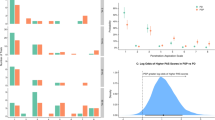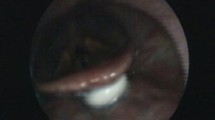Abstract
Deep brain stimulation (DBS) is a common treatment for motor symptoms of Parkinson disease (PD), a condition associated with increased risk of dysphagia. The effect of DBS on swallowing function has not been comprehensively evaluated using gold-standard imaging techniques, particularly for globus pallidus internus (GPi) DBS. The objective of this retrospective, cross-sectional study was to identify differences in swallowing safety and timing kinematics among PD subjects with and without GPi DBS. We investigated the effects of unilateral and bilateral GPi DBS as well as the relationship between swallowing safety and DBS stimulation parameters, using retrospective analysis of videofluoroscopy recordings (71 recordings from 36 subjects) from electronic medical records. Outcomes were analyzed by surgical status (pre-surgical, unilateral DBS, bilateral DBS). The primary outcome was percent of thin-liquid bolus trials rated as unsafe, with Penetration-Aspiration Scale scores of 3 or higher. Secondary analyses included swallowing timing measures, relationships between swallowing safety and DBS stimulation parameters, and Dynamic Imaging Grade of Swallowing Toxicity ratings. Most subjects swallowed all boluses safely (19/29 in the pre-surgical, 16/26 in the unilateral DBS, and 10/16 in the bilateral DBS conditions). Swallowing safety impairment did not differ among stimulation groups. There was no main effect of stimulation condition on timing metrics, though main effects were found for sex and bolus type. Stimulation parameters were not correlated with swallowing safety. Swallowing efficiency and overall impairment did not differ among conditions. These results provide evidence that GPi DBS does not affect pharyngeal swallowing function. Further, prospective, investigations are needed.



Similar content being viewed by others
Data Availability
The datasets generated during and/or analyzed during the current study are available from the corresponding author on reasonable request.
References
Weaver FM, Follett K, Stern M, et al. Bilateral deep brain stimulation vs best medical therapy for patients with advanced parkinson disease: A randomized controlled trial. JAMA. 2009;301:63–73. https://doi.org/10.1001/jama.2008.929.
Won JH, Byun SJ, Oh B-M, et al. Risk and mortality of aspiration pneumonia in Parkinson’s disease: a nationwide database study. Sci Rep. 2021;11:6597. https://doi.org/10.1038/s41598-021-86011-w.
Plowman-Prine EK, Sapienza CM, Okun MS, et al. The relationship between quality of life and swallowing in Parkinson’s disease. Mov Disord. 2009;24:1352–8. https://doi.org/10.1002/mds.22617.
Ramirez-Zamora A, Ostrem JL. Globus pallidus interna or subthalamic nucleus deep brain stimulation for Parkinson disease: a review. JAMA Neurol. 2018;75:367–72. https://doi.org/10.1001/jamaneurol.2017.4321.
Lee DJ, Lozano CS, Dallapiazza RF, Lozano AM. Current and future directions of deep brain stimulation for neurological and psychiatric disorders: JNSPG 75th Anniversary Invited Review Article. J Neurosurg. 2019;131:333–42. https://doi.org/10.3171/2019.4.JNS181761.
Asahi T, Inoue Y, Hayashi N, et al. Alleviation of dysphagia after deep brain stimulation: Results from a Parkinson’s disease patient. Mov Disord. 2012;27:325–6. https://doi.org/10.1002/mds.23899.
Ciucci MR, Barkmeier-Kraemer JM, Sherman SJ. Subthalamic nucleus deep brain stimulation improves deglutition in Parkinson’s disease. Mov Disord. 2008;23:676–83. https://doi.org/10.1002/mds.21891.
Wolz M, Hauschild J, Fauser M, et al. Immediate effects of deep brain stimulation of the subthalamic nucleus on nonmotor symptoms in Parkinson’s disease. Parkinsonism Relat Disord. 2012;18:994–7. https://doi.org/10.1016/j.parkreldis.2012.05.011.
Zibetti M, Torre E, Cinquepalmi A, et al. Motor and nonmotor symptom follow-up in parkinsonian patients after deep brain stimulation of the subthalamic nucleus. ENE. 2007;58:218–23. https://doi.org/10.1159/000107943.
Bejjani B-P, Gervais D, Arnulf I, et al. Axial parkinsonian symptoms can be improved: the role of levodopa and bilateral subthalamic stimulation. J Neurol Neurosurg Psychiatry. 2000;68:595–600. https://doi.org/10.1136/jnnp.68.5.595.
Derrey S, Chastan N, Maltete D, et al. Impact of deep brain stimulation on pharyngo-esophageal motility: a randomized cross-over study. Neurogastroenterol Motil. 2015;27:1214–22. https://doi.org/10.1111/nmo.12607.
Kitashima A, Umemoto G, Tsuboi Y, et al. Effects of subthalamic nucleus deep brain stimulation on the swallowing function of patients with Parkinson’s disease. Parkinsonism Relat Disord. 2013;19:480–2. https://doi.org/10.1016/j.parkreldis.2012.10.023.
Kulneff L, Sundstedt S, Olofsson K, et al. Deep brain stimulation – effects on swallowing function in Parkinson’s disease. Acta Neurol Scand. 2013;127:329–36. https://doi.org/10.1111/ane.12019.
Olchik MR, Ghisi M, Ayres A, et al. The impact of deep brain stimulation on the quality of life and swallowing in individuals with Parkinson’s disease. Int Arch Otorhinolaryngol. 2018;22:125–9. https://doi.org/10.1055/s-0037-1603466.
Silbergleit AK, LeWitt P, Junn F, et al. Comparison of dysphagia before and after deep brain stimulation in Parkinson’s disease. Mov Disord. 2012;27:1763–8. https://doi.org/10.1002/mds.25259.
Lengerer S, Kipping J, Rommel N, et al. Deep-brain-stimulation does not impair deglutition in Parkinson’s disease. Parkinsonism Relat Disord. 2012;18:847–53. https://doi.org/10.1016/j.parkreldis.2012.04.014.
Xu C, Zhuang P, Hallett M, et al. Parkinson’s disease motor subtypes show different responses to long-term subthalamic nucleus stimulation. Front Hum Neurosci. 2018;12:365. https://doi.org/10.3389/fnhum.2018.00365.
Merola A, Zibetti M, Angrisano S, et al. Parkinson’s disease progression at 30 years: a study of subthalamic deep brain-stimulated patients. Brain. 2011;134:2074–84. https://doi.org/10.1093/brain/awr121.
Krause M, Fogel W, Mayer P, et al. Chronic inhibition of the subthalamic nucleus in Parkinson’s disease. J Neurol Sci. 2004;219:119–24. https://doi.org/10.1016/j.jns.2004.01.004.
Fagbami OY, Donato AA. Stridor and dysphagia associated with subthalamic nucleus stimulation in Parkinson disease: case report. J Neurosurg. 2011;115:1005–6. https://doi.org/10.3171/2011.7.JNS11602.
Rosenbek JC, Robbins JA, Roecker EB, et al. A penetration-aspiration scale. Dysphagia. 1996;11:93–8. https://doi.org/10.1007/bf00417897.
Troche MS, Brandimore AE, Foote KD, et al. Swallowing outcomes following unilateral STN vs. GPi surgery: a retrospective analysis Dysphagia. 2014;29:425–31. https://doi.org/10.1007/s00455-014-9522-0.
McHorney CA, Bricker DE, Kramer AE, et al. The SWAL-QOL outcomes tool for oropharyngeal dysphagia in adults: I. Conceptual foundation and item development Dysphagia. 2000;15:115–21. https://doi.org/10.1007/s004550010012.
Henry KA, Singh R, Zhang N, et al. Effect of STN/GPi DBS on swallowing function in Parkinson’s disease as assessed by Video fluoroscopy: A retrospective study. Parkinsonism Relat Disord. 2022;103:136–40. https://doi.org/10.1016/j.parkreldis.2022.08.017.
Hariz MI, Rehncrona S, Quinn NP, et al. Multicenter study on deep brain stimulation in Parkinson’s disease: an independent assessment of reported adverse events at 4 years. Mov Disord. 2008;23:416–21. https://doi.org/10.1002/mds.21888.
Anderson VC, Burchiel KJ, Hogarth P, et al. Pallidal vs subthalamic nucleus deep brain stimulation in Parkinson disease. Arch Neurol. 2005;62:554–60. https://doi.org/10.1001/archneur.62.4.554.
Odekerken VJ, van Laar T, Staal MJ, et al. Subthalamic nucleus versus globus pallidus bilateral deep brain stimulation for advanced Parkinson’s disease (NSTAPS study): a randomised controlled trial. The Lancet Neurology. 2013;12:37–44. https://doi.org/10.1016/S1474-4422(12)70264-8.
Troche MS, Brandimore AE, Hegland KW, et al. Tailored deep brain stimulation optimization for improved airway protective outcomes in Parkinson’s disease. Interdiscip Neurosurg. 2016;5:3–5. https://doi.org/10.1016/j.inat.2016.03.003.
Aldridge D, Theodoros D, Angwin A, Vogel AP. Speech outcomes in Parkinson’s disease after subthalamic nucleus deep brain stimulation: A systematic review. Parkinsonism Relat Disord. 2016;33:3–11. https://doi.org/10.1016/j.parkreldis.2016.09.022.
Follett KA, Weaver FM, Stern M, et al (2010) Pallidal versus Subthalamic Deep-Brain Stimulation for Parkinson’s Disease. In: https://doi.org/10.1056/NEJMoa0907083. https://www.nejm.org/doi/https://doi.org/10.1056/NEJMoa0907083. Accessed 18 Jun 2021
Chiu SY, Tsuboi T, Hegland KW, et al. Dysarthria and speech intelligibility following Parkinson’s disease globus pallidus internus deep brain stimulation. J Parkinson’s Dis. 2020;10:1493–502. https://doi.org/10.3233/JPD-202246.
Østergaard K, Sunde N, Dupont E. Effects of bilateral stimulation of the subthalamic nucleus in patients with severe Parkinson’s disease and motor fluctuations. Mov Disord. 2002;17:693–700. https://doi.org/10.1002/mds.10188.
Pötter-Nerger M, Volkmann J. Deep brain stimulation for gait and postural symptoms in Parkinson’s disease. Mov Disord. 2013;28:1609–15. https://doi.org/10.1002/mds.25677.
George RJS, Nutt JG, Burchiel KJ, Horak FB. A meta-regression of the long-term effects of deep brain stimulation on balance and gait in PD. Neurology. 2010;75:1292–9. https://doi.org/10.1212/WNL.0b013e3181f61329.
Xie T, Padmanaban M, Bloom L, et al. Effect of low versus high frequency stimulation on freezing of gait and other axial symptoms in Parkinson patients with bilateral STN DBS: A mini-review. Transl Neurodegener. 2017. https://doi.org/10.1186/s40035-017-0083-7.
Xie T, Vigil J, MacCracken E, et al. Low-frequency stimulation of STN-DBS reduces aspiration and freezing of gait in patients with PD. Neurology. 2015;84:415–40. https://doi.org/10.1212/WNL.0000000000001184.
Karl JA, Ouyang B, Goetz S, Metman LV. A novel DBS paradigm for axial features in Parkinson’s disease: A randomized crossover study. Mov Disord. 2020;35:1369–78. https://doi.org/10.1002/mds.28048.
Xie T, Bloom L, Padmanaban M, et al. Long-term effect of low frequency stimulation of STN on dysphagia, freezing of gait and other motor symptoms in PD. J Neurol Neurosurg Psychiatry. 2018;89:989–94. https://doi.org/10.1136/jnnp-2018-318060.
Hughes AJ, Daniel SE, Kilford L, Lees AJ. Accuracy of clinical diagnosis of idiopathic Parkinson’s disease: A clinico-pathological study of 100 cases. J Neurol Neurosurg Psychiatry. 1992;55:181–4. https://doi.org/10.1136/jnnp.55.3.181.
Donohue C, Robison R, DiBiase L, et al. Comparison of validated videofluoroscopic outcomes of pharyngeal residue: Concordance between a perceptual, ordinal, and bolus-based rating scale and a normalized pixel-based quantitative outcome. J Speech Lang Hear Res. 2022;65:2510–7. https://doi.org/10.1044/2022_JSLHR-21-00659.
Bhutada AM, DeyMartin -Harris Bonnie, (Focht ) Garand Kendrea L R. Factors influencing initiation of pharyngeal swallow in healthy adults. Am J Speech Lang Pathol. 2020;29:1956–64. https://doi.org/10.1044/2020_AJSLP-20-00027.
Okun MS, Fernandez HH, Wu SS, et al. Cognition and mood in Parkinson’s disease in subthalamic nucleus versus globus pallidus interna deep brain stimulation: The COMPARE trial. Ann Neurol. 2009;65:586–95. https://doi.org/10.1002/ana.21596.
Molfenter SM, Steele CM. Kinematic and temporal factors associated with penetration–aspiration in swallowing liquids. Dysphagia. 2014;29:269–76. https://doi.org/10.1007/s00455-013-9506-5.
Hutcheson KA, Barrow MP, Barringer DA, et al. Dynamic Imaging Grade of Swallowing Toxicity (DIGEST): scale development and validation. Cancer. 2017;123:62–70. https://doi.org/10.1002/cncr.30283.
Landis JR, Koch GG. The measurement of observer agreement for categorical data. Biom. 1977;33:159–74. https://doi.org/10.2307/2529310.
Koo TK, Li MY. A guideline of selecting and reporting intraclass correlation coefficients for reliability research. J Chiropr Med. 2016;15:155–63. https://doi.org/10.1016/j.jcm.2016.02.012.
Daggett A, Logemann J, Rademaker A, Pauloski B. Laryngeal penetration during deglutition in normal subjects of various ages. Dysphagia. 2006;21:270–4. https://doi.org/10.1007/s00455-006-9051-6.
Steele CM, Peladeau-Pigeon M, Barbon CAE, et al. Reference values for healthy swallowing across the range from thin to extremely thick liquids. J Speech Lang Hear Res. 2019;62:1338–63. https://doi.org/10.1044/2019_JSLHR-S-18-0448.
Humbert IA, Sunday KL, Eleni K, et al. Swallowing kinematic differences across frozen, mixed, and ultrathin liquid boluses in healthy adults: age, sex, and normal variability. J Speech Lang Hear Res. 2018;61:1544–59. https://doi.org/10.1044/2018_JSLHR-S-17-0417.
Acknowledgements
We would like to thank Chuck Jacobson, IV, for his assistance with querying the UF INFORM database.
Funding
This research did not receive specific grant funding from any agencies.
Author information
Authors and Affiliations
Contributions
All authors contributed to the study conception and design. Material preparation, data collection and analysis were performed by MSH, NH, and JW. The first draft of the manuscript was written by MSH, and all authors commented on previous versions of the manuscript. All authors read and approved the final manuscript.
Corresponding author
Ethics declarations
Competing Interests
The authors have no competing interests to declare that are relevant to the content of this article.
Additional information
Publisher's Note
Springer Nature remains neutral with regard to jurisdictional claims in published maps and institutional affiliations.
Supplementary Information
Below is the link to the electronic supplementary material.
Rights and permissions
Springer Nature or its licensor (e.g. a society or other partner) holds exclusive rights to this article under a publishing agreement with the author(s) or other rightsholder(s); author self-archiving of the accepted manuscript version of this article is solely governed by the terms of such publishing agreement and applicable law.
About this article
Cite this article
Smith-Hublou, M., Herndon, N., Wong, J.K. et al. Impacts of Deep Brain Stimulation of the Globus Pallidus Internus on Swallowing: A Retrospective, Cross-Sectional Study. Dysphagia (2024). https://doi.org/10.1007/s00455-023-10660-4
Received:
Accepted:
Published:
DOI: https://doi.org/10.1007/s00455-023-10660-4




